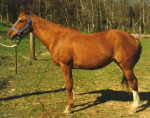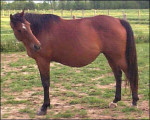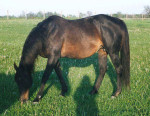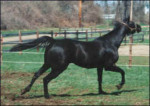
Starting Point: Base Colors
The two basic pigment colors, black and red
Color in mammals is caused by a pigment called melanin.
In horses, melanin appears in two forms, eumelanin (black) and phaeomelanin (orange-red). These two pigments are the source of every horse color. All of the many shades and colors that can occur are
caused by these two pigments interacting with each other, and with the various "modifying" genes that cause them to be lighter or darker or to have white added in various ways. All horses have the
ability to make red pigment (although it may be modified or hidden), but only some horses have the ability to make black pigment. If a horse has black pigment, that doesn't necessarily mean it will
be black -- various other genes can modify or restrict the black pigment.
The starting point for our understanding of horse colors is the group called "base colors".
In understanding this group of colors, it's important to remember that there are two different genes at work, and they are inherited completely independently from one another. Understanding this will
explain how you can, for instance, get a bay from a black x chestnut cross, even though bay is dominant to both black and chestnut. Because of this interaction, we have chosen to cover these two
genes together in one section, rather than separately. Conventional terminology refers to this group of colors as "base colors", or sometimes "hard colors" (from an old time belief that lighter
colors were "weaker" and dark coats were "tougher"). It is also important to understand that these are the "starting point" for every other color, that, for instance, grey is not a color of its own,
but rather a grey horse started out as one of these colors and then had the grey gene added on top of that "base color". As another example, buckskin is not a color of its own, but rather, is a bay
horse with a particular dilution gene added, making it lighter.
The first gene is called the "E" gene.
It was named the "Extension" locus because the dominant allele, E, "extends" the eumelanin (black pigment). The recessive allele, e, blocks the eumelanin, leaving only phaeomelanin (red pigment).
When the black pigment is present, that is what we see, so the horse looks black (in the absence of any further modifying genes, which will be discussed later). Therefore, ee would give a red
(chestnut) horse, EE would give a black horse which cannot produce a chestnut foal, and Ee would give a black horse that can produce a chestnut foal. There is now a DNA test which can tell you
exactly which "E" genes your horse is carrying. It's especially popular with breeders that are partial to the color black, since a black horse that is EE will never have a chestnut foal, and when
bred to another black, will always have a black foal. But the test can come in handy in solving some kinds of color mysteries, too, since some colors can look very similar to each other.
Some older books have theorized that there is a third allele, called ED, dominant to the other two, which would explain the "non-fading black" which is rare, but occasionally seen. However, more
recent studies have discounted this theory. It is a fact that some very few black horses do not fade in the sun, but it is unknown at this time what genetic mechanism causes this. One theory that has
been conclusively disproved is that the "faders" are Ee, and the "non-faders" are EE. Now that there is a test for the "E" genes, plenty of blacks that fade terribly have been identified as EE, so
that can't be the answer.
The second gene is called the "A" gene.
It was named the "Agouti" gene because it was thought to be similar to the color of a South American rodent of the same name. The term was used in mouse color genetics to refer to a gene that
controls the distribution of eumelanin, and apparently the name carried over to the horse gene as well; however, it is now reasonably certain that this gene in horses does not act the same as the one
of the same name in mice. This gene is interesting because of the fact that there are at least three possible alleles, maybe more, unlike the usual two possible alleles as is the case with most horse
color genes.
The Agouti alleles are:
A, which is dominant, and causes the eumelanin (black) to be restricted to the horse's points (mane, tail, legs), leaving the rest of the body
red, and giving us a bay horse. This is the most common horse color in many breeds.
a, which is recessive, and which does not restrict the eumelanin in any way, but allows it to be fully expressed all over the horse's body, thus
giving us a black horse. It is more common in some breeds and less common in others.
Considering these two alleles, we can see that AA would give us a bay horse that can never have a black foal, Aa would give us a bay horse that can have a black foal, and aa would give us a black horse.
The a allele was isolated in 2000 by a lab in France, and there has been a test available since early 2003. It can tell you if your horse has one
a, two of them, or none. Anything not a is labeled A by default, because the test is only detecting the a allele. So, keep in mind that this test can't
distinguish between bay and brown. It is useful in many cases, though.
At, which is dominant to a but recessive to A, which causes seal brown. This allele has only recently been isolated by Pet DNA of Arizona (http://www.petdnaservicesaz.com/Equine.html). They now offer a
test for it. Note that this is a separate test from the one for the a allele.
Another allele which is theorized, but not genetically proven at this point in time is:
A+, which is dominant over all the other alleles at the A locus. It is called "wild type" bay, and gives a much lighter horse with
shading that makes them look much lighter on the underbelly, and the black on the legs is much less extensive (perhaps only up to the ankles). Some books specify the color of the Przewalski's Horse
as an example of this gene, but pictures of them show that they are actually dun. Perhaps they are A+ and dun, both. It is possible
that this gene was once the most common color in all horses, but has been almost completely bred out of the modern horse population.
The various Agouti alleles affect only the eumelanin in the horse's coat, and therefore would have no visible effect on a chestnut horse, which has no black pigment to be affected. There are some who
believe that the various A alleles may affect the shade of a chestnut, but at this point there is no evidence that this is true. Anecdotal evidence does suggest that black (aa) horses seem more
likely to produce very dark chestnuts (liver chestnuts) when they do have chestnut foals, and vice versa, so there may be something to the idea. However, the one study that was done by the
researchers who isolated the a allele showed no statistically significant difference in
the shades of chestnuts whether they were AA, Aa or aa. Hopefully more research will be done in this area soon.
Descriptions and examples of our four "base colors", then:
1. Chestnut (AKA sorrel) (ee, with any combination of A genes)
2. Bay (AA, Aa, or AAt, plus EE or Ee)
3. Brown (AtAt or Ata, plus EE or Ee)
There is now a DNA test to differentiate this color from bay or black. It's definitely a separate and distinct color meriting a category of its own. The color is called "black and tan" in some countries, which is an apt description. The basic appearance is that of a black horse with tan highlights in specific areas -- the muzzle, flanks, underbelly, and girth areas. The darkest shades of seal brown would be almost all black except for a little tan at the muzzle and flank, while the lighter ones look more like a tan horse with an overlay of black covering a good deal of the body, and the very lightest shades of seal brown might look very much like some bays. At one time a theory was proposed that seal brown was caused by a solid black base color with a 'pangare' gene, however, this theory was disproved when the a allele was isolated and a test for it developed -- since none of the seal browns that have been tested turned out to be aa, they could not be "black plus" anything.
4. Black (EE or Ee, plus aa)
The horse is black all over, including the muzzle, flanks and underbelly. Blacks are notorious for fading and bleaching when exposed to the sun, so it can be hard to identify a black horse that has been out in the sun - they might look more like some strange shade of bay, brown or even dun! But once the new coat comes in, they will be all black again (for awhile, at least).
What you can get when crossing these colors:
(x = "crossed with")
Chestnut x chestnut will always give a chestnut foal.
Black x black will always give a black foal if at least one parent is EE. If both parents are Ee, then the chance of black is 75% and the remaining 25% would be chestnut.
Brown x brown may be expected to produce brown, black, or chestnut, but not bay.
Bay x bay can produce any of these colors. If one parent is EE, AA then every foal will be
bay. If both parents are Ee, Aa then the chances are 56.25% bay, 18.75% black, and 25%
chestnut.
Chestnut x any of the other three "black-based" colors gives the potential of producing any of the base colors, since there is no way of knowing which of the "A" genes that chestnut might have. If a
chestnut that was ee, AA was bred to a black that was EE, aa then every single foal would be bay. If a chestnut has one black parent, then we can be sure it
has at least one a, and if it has two black parents, then we know it is aa. Therefore, a
chestnut that had two black parents, when bred to a black which is EE, will produce all black foals. But chestnuts from bay or chestnut parents
could be carrying any of the "A" genes, and there is no way of knowing. If a chestnut produced a bay foal when bred to a black, that would be proof that the chestnut had at least one A.
Original Web & Graphics Design © 2000-2009 by B. Kostelnik, Hippo-Logistics.com
Text © 2000-2014 by Julia Lord and horsecolor.com
All photos © by photographer and are used with permission.
If you'd like to have your horse's picture considered for use as an example on this site, you may submit it to us as an email attachment.











